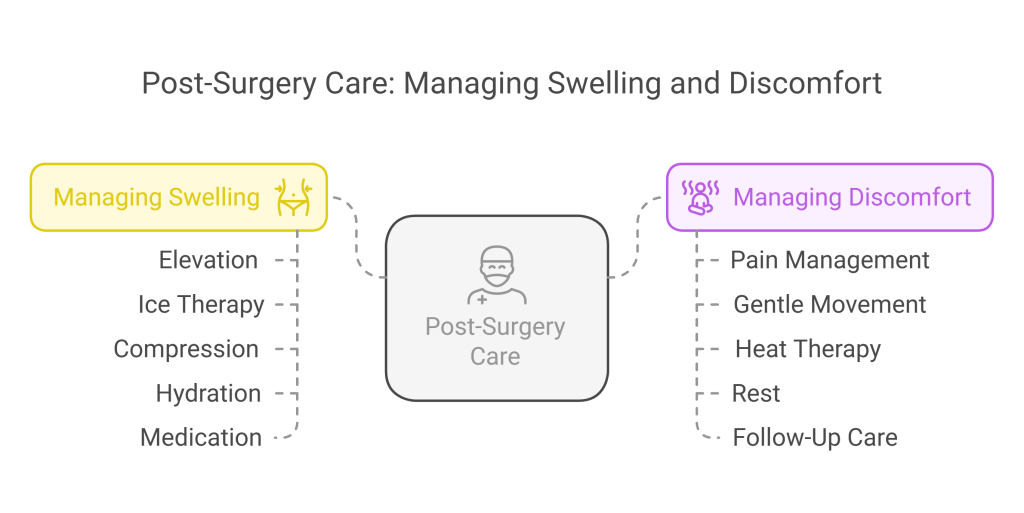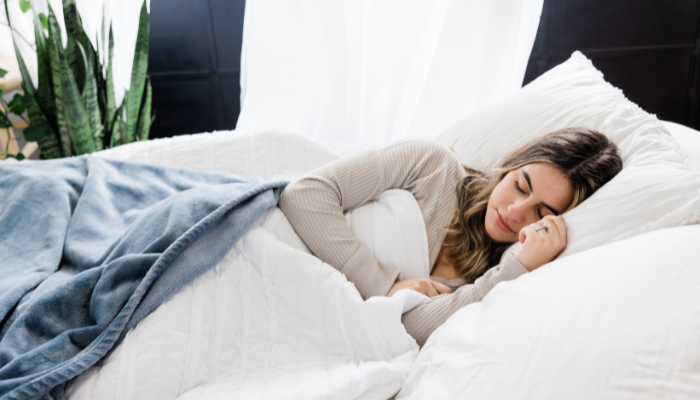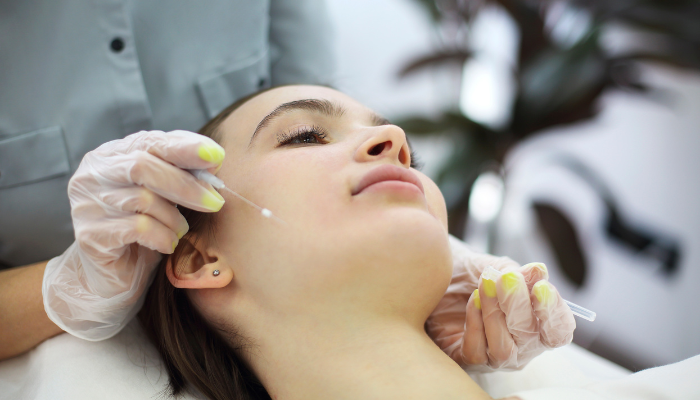After getting nose fillers, many people wonder how to get a good night’s sleep without compromising their results. The right sleeping position and care can make a big difference in how your nose heals and looks after the procedure.
Here’s a handy guide to help you navigate those first nights post-treatment.
Key Takeaways
- Sleep on your back to avoid pressure on your nose.
- Elevate your head with pillows to reduce swelling.
- Avoid sleeping on your side or stomach for at least a week.
- Stay hydrated to aid recovery and skin health.
- Monitor for any unusual symptoms and contact your practitioner if needed.
Understanding The Importance Of Sleeping Position
It’s easy to overlook how much your sleeping position matters after getting nose filler, but trust me, it’s pretty important. I mean, you’ve just invested in yourself, right? So, let’s make sure you protect that investment while you catch some Z’s.
Basically, how you sleep can really affect how well the filler settles and, ultimately, how happy you are with the results.
Why Your Sleeping Position Matters
Think of it this way: those fillers need time to settle properly. Pressure on the treated area, especially in the first few nights, can actually disrupt this process. It’s all about giving the filler the best chance to integrate smoothly. Imagine trying to set jelly, but someone keeps poking it – not ideal, is it?
Risks Of Sleeping Incorrectly After Fillers
Okay, so what happens if you don’t pay attention to your sleeping position? Well, a few things could go wrong, and none of them are great. You might end up with:
- Filler Migration: This is where the filler shifts from where it was originally placed. Not good if you want a symmetrical look.
- Increased Swelling or Bruising: Sleeping on your face can make any swelling or bruising worse. Who wants to wake up looking like they’ve gone a round with a boxer?
- Asymmetry: Uneven pressure can lead to one side healing differently from the other. Basically, your nose could end up looking a bit wonky.
It’s worth taking a bit of extra care for a few nights to avoid these issues. A little effort now can save you potential stress and further appointments later on.
How Sleeping Affects Filler Settlement
So, how exactly does sleep affect filler settlement? Well, it’s all about pressure and blood flow. When you lie face down, you’re putting direct pressure on the treated area, which can restrict blood flow and potentially move the filler.
Sleeping on your back, on the other hand, allows for even distribution and reduces the risk of complications. It’s a simple change that can make a big difference.
Recommended Sleeping Positions After Treatment
Alright, so you’ve just had your nose filler done, and you’re probably wondering how to sleep without messing things up. Don’t worry, it’s pretty straightforward. The goal here is to avoid putting any unnecessary pressure on your nose while the filler settles. Here’s the lowdown on the best sleeping positions to adopt.
Sleep On Your Back
Sleeping on your back is definitely the safest bet after getting nose fillers. It’s like giving your face a night off. This position ensures that there’s no direct pressure on the treated area, which is super important for letting the filler settle properly.
Think of it as letting your face rest easy. It might feel a bit weird if you’re not used to it, but trust me, it’s worth it for the sake of your results.
Elevate Your Head
Propping yourself up a bit can really help reduce any swelling. Just grab an extra pillow or two. Elevating your head encourages fluid to drain away from your face, which means less puffiness when you wake up. It’s a simple trick, but it makes a noticeable difference. Plus, it can make you feel a bit more comfortable overall.
Avoid Sleeping On Your Side Or Stomach
Okay, this one’s important. For at least the first night, try your absolute best to avoid sleeping on your side or stomach. These positions put direct pressure on your nose, and that’s exactly what we’re trying to avoid.
Pressure can cause the filler to move, leading to uneven results, and nobody wants that. It might be tough if you’re a dedicated side-sleeper, but it’s a temporary sacrifice for the sake of your lovely new nose.
Managing Swelling And Discomfort

After nose filler, you’re probably wondering how to deal with any swelling or discomfort. Don’t worry, it’s all part of the process, and there are a few things you can do to make yourself more comfortable.
Use Extra Pillows
Propping yourself up a bit can really help. I usually grab a couple of extra pillows and stack them so I’m not lying completely flat. This helps to reduce swelling by encouraging fluid to drain away from your face.
It’s a simple trick, but it makes a difference. I find it also stops me from rolling onto my side in my sleep, which is a bonus.
Consider A Wedge Pillow
If you’re serious about keeping your head elevated, a wedge pillow might be a good shout. They’re designed to keep you at an angle all night, which can be more comfortable than trying to arrange a bunch of regular pillows. Plus, they’re pretty comfy even when you don’t have nose filler!
Stay Hydrated
Honestly, staying hydrated is good advice for just about anything, but it’s especially important after getting fillers. Drinking plenty of water helps your body heal and can minimise swelling. Try to keep a water bottle next to your bed so you can sip throughout the night. It’s a small thing, but it all adds up. Plus, avoiding salty foods can also help prevent water retention, which is a win-win.
Practical Tips For Better Sleep
Everything also comes down in protecting your investment. Let’s look at some practical things you can do to improve your sleep quality while keeping your nose safe.
Create A Comfortable Sleep Environment
Your bedroom should be your sanctuary, now more than ever. Think about optimising it for sleep. This means making sure it’s dark, quiet, and cool. Blackout curtains can be a game-changer if you’re sensitive to light.
Earplugs or a white noise machine can help block out distracting sounds. And keep the temperature on the cooler side – around 16-18°C is often recommended for optimal sleep. Basically, make it a place you actually want to be.
Limit Distractions
We all know we should limit screen time before bed, but it’s so tempting to scroll through social media, isn’t it? Try to resist! The blue light emitted from phones and tablets can interfere with your sleep cycle.
Instead, try reading a book (a real one, not on a screen), listening to calming music, or doing some gentle stretching. The goal is to wind down and signal to your brain that it’s time to sleep. I find a cup of chamomile tea helps too.
Use Silk Pillowcases
Okay, this might sound a bit bougie, but hear me out. Silk pillowcases are actually really good for your skin and hair. Because they’re so smooth, they reduce friction, which means less tugging and pulling on your face while you sleep.
This is especially important after nose filler, as you want to minimise any potential pressure or movement. Plus, they just feel nice! It’s a small luxury that can make a big difference.
Monitoring Your Recovery
It’s really important to keep an eye on how you’re healing after getting nose filler. Most of the time, things go smoothly, but knowing what to look for can help catch any potential issues early on. Being proactive is key to a good outcome.
When To Contact Your Practitioner
Don’t hesitate to get in touch with your qualified practitioner if you’re worried about anything. Seriously, it’s better to be safe than sorry. Here are a few things that should prompt a call:
- Severe pain: If the pain is way worse than you expected and doesn’t get better with painkillers.
- Sudden swelling or bruising: A bit of swelling is normal, but if it suddenly gets much worse, or if you get a lot of bruising out of nowhere, give them a ring.
- Any signs of infection: Redness, warmth, pus, or a fever could mean an infection.
Signs Of Complications
While complications are rare, it’s good to know what they might look like. Keep an eye out for:
- Changes in skin colour: If the skin around the injection site turns very pale or mottled, it could be a sign of a vascular issue.
- Unusual lumps or bumps: Sometimes, filler can migrate or clump together. If you notice anything like this, let your practitioner know.
- Vision changes: Although extremely rare, any changes in your vision after filler should be checked out immediately.
Remember, your practitioner is there to support you through the whole process. If something doesn’t feel right, trust your gut and reach out to them.
Follow-Up Appointments
Make sure you go to any follow-up appointments your practitioner schedules. These appointments are a chance for them to check how you’re healing and make sure everything is settling as it should. They can also address any concerns you might have and offer advice on aftercare. It’s a good opportunity to ask any questions that have popped up since your treatment.
Lifestyle Adjustments For Optimal Healing
Limit Alcohol And Avoid Smoking
A glass of wine after a long day sounds amazing, and some people really enjoy a cigarette. But, excessive alcohol and smoking can really mess with your skin’s elasticity and overall health, which isn’t ideal when you’re trying to heal after nose filler.
These habits can actually compromise the results you’re hoping for. If you can, try to cut back or quit altogether, especially during the initial recovery period. It’s a small sacrifice for better, longer-lasting results, right?
Incorporate Anti-Inflammatory Foods
What you eat can actually make a difference in how quickly you heal. Try adding some anti-inflammatory foods to your diet. Think things like salmon, walnuts, and berries. These are packed with omega-3 fatty acids and antioxidants, which can help reduce inflammation and boost your skin’s health.
It’s like giving your body a little extra help from the inside out. I’ve been trying to add more turmeric to my meals too, apparently that’s a good one!
Maintain A Healthy Skincare Routine
- Gentle Cleansing: When you’re washing your face, be super gentle around your nose. Use a mild, fragrance-free cleanser to avoid irritating the area. Harsh stuff can mess with your skin’s balance and interfere with the filler settling properly.
- Sun Protection: Protect your investment by shielding your nose from the sun. UV rays can actually speed up the breakdown of the filler. So, slap on some broad-spectrum sunscreen with at least SPF 30, even when it’s cloudy. A wide-brimmed hat is a good shout too.
- Hydration: Staying hydrated is key for, well, everything, including healing. Water helps flush out toxins and keeps your skin looking its best. Aim for at least six glasses a day. It’s a simple thing, but it makes a difference.
Remember, these are just guidelines. Everyone heals at their own pace, so listen to your body and don’t hesitate to reach out to your practitioner if you have any concerns. A little extra care can go a long way in ensuring you get the best possible results from your nose filler.
Using Sleep Aids And Devices
Avoid Pressure From Sleep Masks
If you’re someone who loves using sleep masks, it’s worth being a bit cautious after getting nose filler. The key thing is to avoid masks that apply firm pressure to your nasal bridge. This is because unnecessary pressure could, in theory, increase the risk of filler migration.
If you can’t ditch the mask completely, try to find one that sits higher on your forehead and doesn’t press directly on your nose.
Consider Nasal Pillow Masks
For those who use sleep apnoea devices, the type of mask you use is important. Full face masks can sometimes put pressure on the nose, which isn’t ideal after filler.
Consider switching to a nasal or nasal pillow mask. These types of masks sit under the nose or directly in the nostrils, avoiding contact with the nasal bridge. It might take a little getting used to, but it’s a worthwhile change to protect your investment.
Consult Your Practitioner About Sleep Aids
If you’re struggling to sleep well after your nose filler treatment, don’t hesitate to chat with your practitioner. They can offer tailored advice and might suggest certain sleep aids that are safe to use.
It’s always best to get professional guidance before trying anything new, especially when it comes to medication or supplements. Your practitioner knows your specific situation and can recommend the best course of action for a restful and safe recovery.
Conclusion
Getting a nose filler is an exciting step towards enhancing your appearance, but it does come with some important aftercare, especially when it comes to sleep. Remember to choose a practitioner with surgical expertise, sleep on your back and keep your head elevated for the first few nights to help reduce swelling and ensure the filler settles properly.
It might feel a bit awkward at first, but with a few extra pillows or a wedge pillow, you can make it work. If you have any concerns or notice anything unusual, don’t hesitate to reach out to your practitioner. With a little care, you’ll be on your way to enjoying your new look in no time.
Frequently Asked Questions
How should I sleep after getting nose fillers?
It’s best to sleep on your back with your head elevated. This helps reduce swelling and keeps the filler in place.
Can I sleep on my side after the treatment?
It’s better to avoid sleeping on your side for at least a week, as it can put pressure on your nose and affect the results.
What if I accidentally roll over while sleeping?
If you roll onto your side, try to gently reposition yourself back onto your back to avoid pressure on your nose.
How can I reduce swelling while I sleep?
Using extra pillows to elevate your head can help reduce swelling by allowing fluids to drain away from the treated area.
Is it safe to use sleep masks after fillers?
Avoid using sleep masks that apply pressure on your nose, as this can increase the risk of filler migration.
When should I contact my practitioner after the treatment?
If you notice unusual swelling, redness, or discomfort, contact your practitioner to discuss your symptoms.





